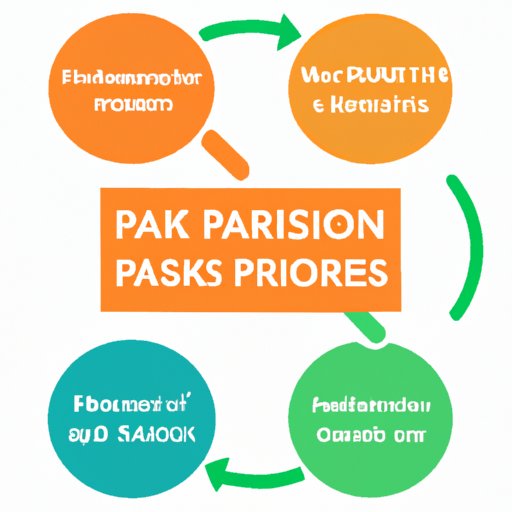
I. Introduction
Parkinson’s disease is a progressive neurological disorder that affects millions of people worldwide. It primarily affects the motor system, leading to symptoms such as tremors, rigidity, and problems with balance and coordination. However, Parkinson’s can also cause non-motor symptoms such as depression, cognitive impairment, and sleep disturbances.
The causes of Parkinson’s are complex and not yet fully understood. However, recent research has shed light on the various genetic and environmental factors that may play a role in its development. In this article, we will explore the different causes of Parkinson’s and how they contribute to the onset and progression of the disease.
II. Exploring the Genetic Factors behind Parkinson’s Disease
Genetic factors refer to any of the inheritable traits dependent upon DNA sequences that determine the individual’s genetic development and features. It is estimated that up to 10% of Parkinson’s cases are caused by specific genetic mutations. These hereditary and familial forms of Parkinson’s are rare, but understanding them can help researchers better understand the disease’s molecular pathways.
Researchers have identified several specific genes associated with Parkinson’s, including SNCA, LRRK2, and PARK2. These genes play a role in the production and regulation of dopamine, a neurotransmitter that is deficient in Parkinson’s patients. Certain genetic mutations can cause these genes to malfunction, leading to a build-up of abnormal proteins in the brain that ultimately result in the death of dopamine-producing neurons.
III. Environmental Triggers: What Causes Parkinson’s Disease in Some Individuals?
Environmental factors such as exposure to toxins or viral infection may trigger Parkinsonism only in susceptible individuals. Exposure to environmental toxins such as heavy metals, pesticides, and solvents has been associated with an increased risk of Parkinson’s disease. These toxins can damage the dopamine-producing neurons in the brain and cause oxidative stress, which can cause inflammation and ultimately lead to cell death.
Additionally, researchers have found a link between certain viruses and Parkinson’s. A study found that people who had been infected with hepatitis B or C were more likely to develop Parkinson’s later in life. Head injuries and trauma to the head can also increase the risk of Parkinson’s disease over time.
IV. The Connection between Aging and Parkinson’s Disease
Aging is a significant risk factor for Parkinson’s disease. The incidence of Parkinson’s increases with age. There is a gradual loss of dopamine-producing neurons, leading to a decline in dopamine levels with age. This decline can cause motor symptoms similar to those seen in Parkinson’s disease, such as slower movements and stiffness throughout the day. This loss of neurons ultimately leads to the onset of Parkinson’s disease.
V. Parkinson’s Disease and Lifestyle Choices: How Diet and Exercise May Play a Role
Lifestyle choices such as diet and exercise can also play a role in Parkinson’s disease. Studies have shown that exercise can slow the progression of Parkinson’s and improve patients’ quality of life. Cardio and weight-bearing exercises can help build and maintain muscle strength, reduce rigidity, and improve balance and overall mobility.
Certain diets, such as the Mediterranean diet, may also have a protective effect against Parkinson’s. This diet includes foods high in antioxidants, such as fruits, vegetables, and nuts. Antioxidants help reduce the impact of free radicals and oxidative stress, which can contribute to the onset of Parkinson’s.
VI. The Role of Free Radicals in Parkinson’s Disease Development
Free radicals are unstable molecules that can damage cells and contribute to aging and disease. When free radicals interact with dopamine in the brain, they can cause oxidative stress, which can ultimately lead to the death of dopamine-producing neurons. Studies have shown that oxidative stress may contribute to the development of Parkinson’s disease. Antioxidants, which neutralize free radicals, can help reduce the impact of oxidative stress and potentially slow Parkinson’s progression.
VII. The Impact of Brain Inflammation on Parkinson’s Disease
Brain inflammation, also known as neuroinflammation, can also play a role in Parkinson’s disease development. Chronic inflammation has been linked to the progressive loss of dopamine-producing neurons, which is a hallmark of Parkinson’s disease. While inflammation is a natural response to injury, chronic inflammation can cause damage to the brain’s immune system. Anti-inflammatory medications may be used to treat Parkinson’s and reduce its symptoms.
VIII. Uncovering the Link between Pesticide Exposure and Parkinson’s Disease
There is a growing body of research on the link between pesticide exposure and Parkinson’s disease. Studies have shown that people who live in rural areas where the use of pesticides is more common are at a higher risk of developing Parkinson’s. Pesticides can impact the brain’s dopamine system and cause oxidative stress, contributing to the onset of Parkinson’s symptoms. While more research is necessary to confirm this link, it highlights the importance of minimizing exposure to environmental toxins and adopting a healthier lifestyle.
IX. Conclusion
In conclusion, Parkinson’s disease is a complex condition with numerous factors that contribute to its onset and progression. Understanding the various genetic and environmental triggers, aging, and lifestyle choices that play a role in Parkinson’s can help researchers develop more effective treatments and potentially prevent its onset. More research is needed to fully understand the causes of Parkinson’s, and therefore, advocating for ongoing research is necessary to fight this debilitating disease.





